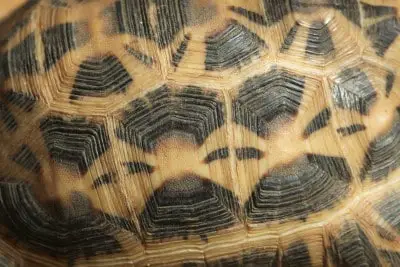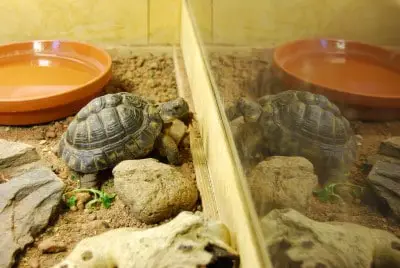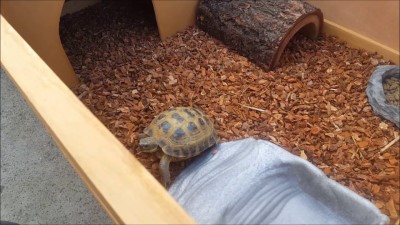Tortoises can indeed live past a generation, but this lifespan may be cut short due to illness-related deaths. While you can easily spot danger signs in other pets like dogs and cats, tortoises are different. It may take some time before you realize that something is amiss, and in most cases, it may be too late.
The most common signs that your tortoise’s health is deteriorating include;
- General body weakness
- Swelling eyes
- Bleeding nose
- Pale mouth
- Difficulty in breathing
- Loss of appetite and drastic weight loss
- Changes in the shell’s appearance, such as pyramiding or bleeding
- Abnormal excretion
- Swollen skin
To help save your pet in the nick of time, we will give you the main symptoms to check. We also explain the next cause of action if you spot any of the signs. Read on as we go deeper into the tortoise’s health and well-being.

How To Tell That a Tortoise Is Dying?
It’s tasking to determine whether your tortoise is healthy or not. You may find it generally inactive, uncertain whether it is still alive. Contrary to other pets’ behaviors, tortoises aren’t hyperactive. If you find them unresponsive, you may think that it’s their usual self.
With warm-blooded pets, you can detect when they are sick because they tend to show some familiar changes such as lethargy, pain, sudden inactivity, and heavy breathing. However, reptiles have different illness symptoms, and, mostly, general inactivity indicates that they are slipping into hibernation.
Some common illnesses will signify that a tortoise needs urgent medical care. Otherwise, the condition may get worse, causing your tortoise to die. The following are some signs to look out for if you’re worried about your pet.
The Shell
The tortoise’s shell is the reptile’s most observable organ and similarly a health indicator. When healthy, the cover should be smooth with well-aligned scutes, without cracks or bends. If you notice any dents on their armor, it’s best to seek medical attention. The tortoise is susceptible to diseases or infections if something happens to its shell. One life-threatening symptom is bleeding from the armor or plastron.
Secondly, when the shell cracks or breaks, it implies that there was force involved; thus, the reptile may also have an internal injury. An untreated crevice may also lead to shell infections. Another severe indicator is softshell with results from calcium deficiency and malnutrition.
Therefore, you may notice shell deformities such as “pyramiding,” where the scutes protrude and appear overlapping. For such cases, consider exposing your pets to adequate sunlight, proper feeding, and adding supplements to their diet.
The Eye
Another clear indicator that something is wrong is the eyes; a healthy tortoise has clear, bright eyes with no abscess. If critical, its eyes appear dull, hollow, or swollen, and you can see the third eyelid.
Similarly, you may notice a puss-like discharge, a sign of lack of vitamin A. When tortoises have eye infections, they start rubbing their eyes due to irritation; this frequent rubbing contributes to the puffiness. Any eye abnormalities are severe and can be fatal if left in that state.
The Nose
Like the eyes, you can use the nose to tell whether your tortoise is healthy or not. Sick tortoises have nasal discharges, mucus, difficult breathing, or wheezing. If your pet has any of these or related signs, it could be suffering from pneumonia or respiratory disease. Such fatal illnesses cause instant death among tortoises unless treated.
The Mouth
A healthy tortoise’s mouth should be pink. This rosy color indicates that it has enough blood cells. Otherwise, the mouth will appear pale or discolored; when pale, the tortoise has few red blood cells and may be suffering from anemia.
It may also be due to internal bleeding or internal organ infections. There are also instances of mouth rot, which are severe. Also, look out for mouth discharges which may be mucus from an illness.
The Weight
It may be challenging to monitor your tortoise’s weight, but it’s an essential factor to consider. Like humans, you can tell that your pet is unwell if it has drastic weight loss by frequently picking them up or placing them on a weighing scale. Usually, it should be heavy, and if not, they have appetite issues or health-related problems. The problem may be a change in feeding, improper digestion, or an internal infection.
The tortoise should regularly feed; else, it may have appetite and digestion issues. This condition is due to internal infections or tract blockage, and in females, it may signify dystocia (egg retention). To be sure, you can monitor their stool for worms, blood traces, or food particles, all indicators of parasite infestation. Other than weight loss, obesity may also be a red flag. If your tortoise drastically gains weight, it may be due to overfeeding.
The Skin
Most animals show ailments through skin changes. For the tortoise, you can tell by looking at the exposed skin like the neck and limbs. An unhealthy tortoise will have reddened skin that resembles a wound or raw flesh. There may also be swelling around the eyes or ears.
With time, these wounds can get infected and emit a foul smell. If these changes happen instantly, then the tortoise may have severe renal disease. Skin issues mostly result from lack of vitamin A and contraction of bacterial infections.
Excretion
One specific way to check for internal issues is by observing the tortoise’s urine and excrements. Urine is typically a transparent liquid with smooth white urates, while feces are mostly hard and dry. In case of a problem with digestion or parasite infestation, you will notice that the stool will be runny or have traces of blood or worms.
Parasites can damage the internal digestive organs unless you help your pet find immediate treatment. Similarly, it’s a problem when your tortoise doesn’t pass stool; this may indicate a blockage in its digestive system. If severe, your pet’s only chances of survival may be surgery.
Inactivity
A healthy tortoise roams around exploring its environment and can approach food and move away from unfavorable conditions. Therefore, if you find your turtle generally unresponsive, the chances are high that it may be ill. The red flags include failure to walk, swim or perform any everyday activity.
There are two leading causes of tortoise inactivity. First, it may be seriously ill or injured, making its body weak. If it’s an injury, your pet may be in pain, thereby limiting movement. It’s best to seek an expert opinion to tell if your pet has a nutrient deficiency, arthritis, gout, or trauma injuries.
Difficulty in Breathing
Abnormal breathing is also an indicator that your tortoise is dying. You can monitor for signs such as heavy breathing, sneezing, yawning, and wheezing sounds. Similarly, there may be nasal discharge, which results from respiratory illnesses like pneumonia.
Consequently, your tortoise may find it easier to breathe through its mouth instead or try moving its head to let in more air. The major symptoms of respiratory issues are puffy eyes, inactivity, and nasal or oral discharges. This condition is fatal, and you need to help your pet as soon as possible.
What To Do When Your Tortoise Is Dying?
Tortoises are hardy reptiles; hence, they can live for years, even in harsh environments. For safety, it’s best to understand the primary symptoms that indicate red flags. Be keen on abnormal behavior and symptoms.
Whether the signs are evident or only a hunch, it’s a good idea to consult tortoise experts. Only they can confirm the gravity of the situation and suggest the way forward. The veterinarians will tell you the next step to take in treating the tortoise. If the experts run out of treatment options, but your buddy is still suffering, the last resort is to dispatch the tortoise.
It would help to regularly check your tortoise for the signs and seek medical attention where necessary to prevent such instances. Some home remedies are also available to lower the severity of the illness or infection.
Finally
Tortoises, unlike other common pets, contract different illnesses and have various symptoms. It may be a while before you realize that your pet is severely ill or even at the brink of death. You may assume that your pet is fine when it could be slowly dying. It may be a long and tasking process to tell whether your pet is ill or going to hibernate.
Therefore, you need to know all the danger signs before it’s too late. Check for abnormalities in the shell, eyes, nose, mouth, or skin. Also, check for excrements which may indicate whether the tortoise has an internal organ issue. You can also look for general inactivity, weight issues, and appetite loss. If you see any of these signs, seek medical attention; it may be your pet’s only chance of surviving.
Read more: How To Comfort a Dying Turtle








